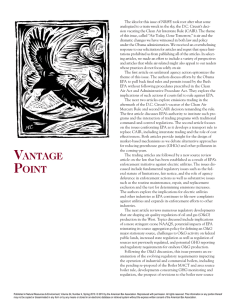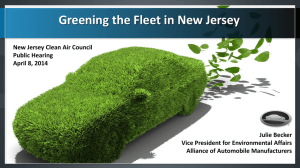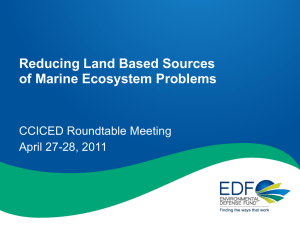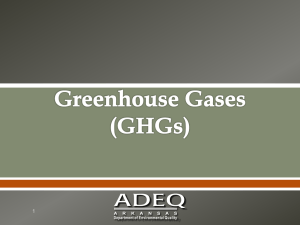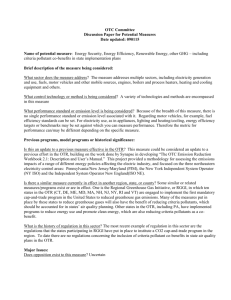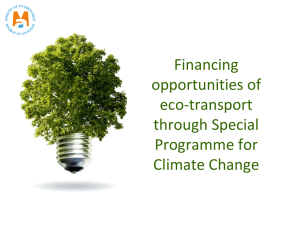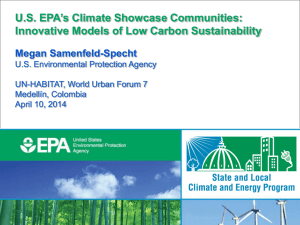EPA Region 9
advertisement
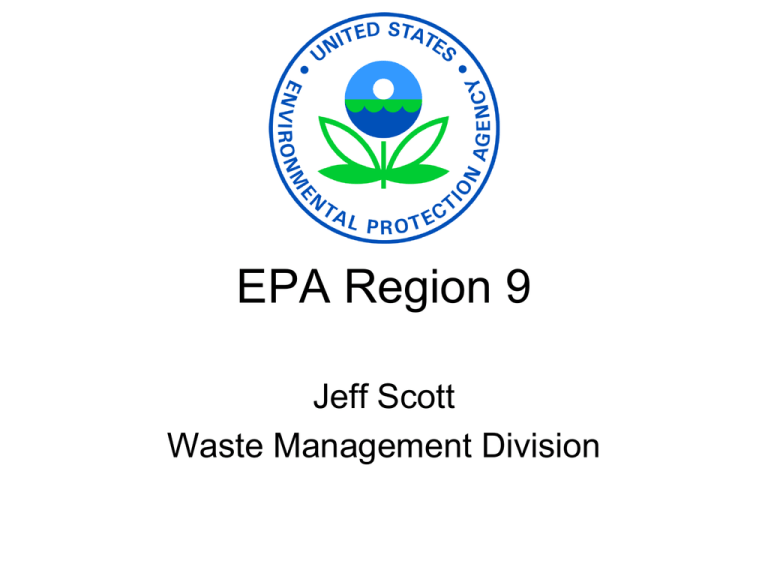
EPA Region 9 Jeff Scott Waste Management Division Administrator Jackson’s Priorities • Reducing GHG emissions • Improving air quality • Managing chemical risks – Risks of chemicals in consumer products, workplaces environment • Cleaning up hazardous waste sites • Accelerate the pace of cleanup • Return properties to productive use • Reduce threats to health/environment • Protecting America’s water Needed GHG Reductions • 83% by 2050? • 14% - 25% by 2020? • By any measure....……..A Long Road Broad Array of GHG reduction options needed Conventional Accounting: Sector Based U.S. GHG Emissions (2006) End-of-pipe focus Leads to technologyoriented strategies Source: U.S. Inventory of GHG Emissions and Sinks : 1990-2006 (US EPA, 2008) Systems Based View: U.S. GHG Emissions (2006) Same GHG emissions, a new lens. Leads to prevention – oriented strategies Source: Draft values from Opportunities to Reduce Greenhouse Gas Emissions through Materials and Land Management Practices. U.S. EPA. (forthcoming). Opportunity Knocks: • In 2006, the U.S. recycled over 80 million tons of municipal solid waste (32.5% recycling rate) – Equivalent to conserving 182 million metric tons of carbon dioxide equivalent (MMCO2E). • Recycling achieves short term, high impact, lower cost GHG reductions – Increase to 50% recycling nationally • 70-80 MMTCO2E per year potential GHG reductions – Increase to 100% recycling nationally • up to 300 MMTCO2E per year potential GHG reductions Grabbing “the low hanging fruit” Advancing Waste Climate Connection West Coast Climate Forum Region 9/10 Partnership Connecting Waste/Materials Management to Climate Change 8 States Engaging West Coast Leading Cities Focus on Tools, Policy and Innovation 9 6 Principles for TSCA Legislative Reform Chemicals - reviewed against safety standards based on sound science and reflect risk-based criteria protective of human health and the environment. Manufacturers provide necessary information to conclude that new and existing chemicals are safe Risk management decisions should take into account sensitive subpopulations, cost, availability of substitutes and other relevant considerations EPA should have clear authority to act - should assess and act on priority chemicals, both existing and new, in a timely manner Green Chemistry – encouraged, transparency and public access to information strengthened EPA should be given a sustained source of funding for implementation Enhanced Chemical Management Program • New Regulatory Risk Management Actions – Lead – Mercury – Formaldehyde – PCBs – Glymes – Nano Materials – Carbon Nano tubes Resources • Essential TSCA Reform Principles – http://www.epa.gov/oppt/existingchemicals/pubs/princip les.html • Enhanced Chemical Management Program – http://www.epa.gov/oppt/existingchemicals/pubs/enhan chems.html • National Partnership for Environmental Priorities (NPEP) – http://www.epa.gov/waste/partnerships/npep/index.htm Evolution of the R9 RCRA Program • Emphasis on successful state implementation of waste program • Expand EPA presence on tribal lands and underserved communities • Moving beyond waste to achieve greater overall results • Multiple years of substantial resource cuts R9 EPA HW Enforcement Priorities • EJ Community Initiatives • Tribal Lands • High Noncompliance –High Risk Sectors/Facilities • National Enforcement Initiatives – Mining/Mineral Processing – Financial Assurance reviews – Surface Impoundments • Ensuring a Level Playing Field Suisun Bay, CA Capacitors PCBs Door jams Electrical insulation PCBs in Caulk Metropolitan Water District, CA LUST Cleanup Challenge • Continued challenge to close 14,000+ LUSTs • American Recovery and Reinvestment Act of 2009 Greening Cleanups • Cleanup paradigm evolution: – Protect HH&E – Reuse contaminated land – Minimize climate/energy footprint of remedy • Better informed remedial decisions through Lifecycle Analysis of carbon, energy, and multi-media impacts LCA Greening Remedies Greening Products: Electronic Product Environmental Assessment Tool Green Standards for Electronics • Reductions AchievedEPEAT for Consumers? 4.4 MMTCO2E 4,290 metric tons toxics • Greening Existing Buildings – GHG opportunities – ARRA Weatherizing homes – Residential – Energy Star Homes – Indoor Air Issues • Healthy Schools – Collaborative for High Performance Schools (CHPS)High Performance Building Products Database • Region 9 actions to support Home Energy Retrofits: –Formed CA HERCC – CA Home Energy Retrofit Coordinating Committee –Developing consistent standards and program elements for statewide utility-and local government-sponsored programs Contact: Leif Magnuson magnuson.leif@epa.gov For CA HERCC Recommendations, see: http://www.builditgreen.org/homeenergy-retrofit-programs-local-government Questions?
